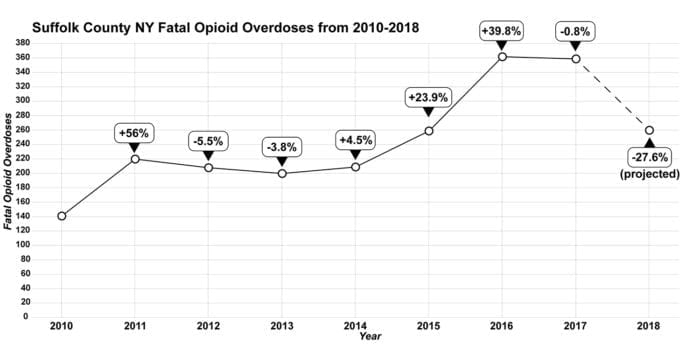Suffolk County’s police department has new numbers to get excited about.
Despite being less than halfway through the year, the police department and medical examiner’s office report the county is on trend to see a nearly 100-person decrease in opioid-related deaths in 2018, compared to the last two.
Chief of Detectives Gerard Gigante and Chief Medical Examiner Michael Caplan confirmed at the May 31 Suffolk County Legislature’s health committee meeting that if numbers remain low through June and July, Suffolk might see overdose deaths drop to 2015 levels — 260 total — compared to 2016 and 2017, where there were 362 and 359, respectively.
“It feels like we’re making headway,” Gigante said. “Like we’re getting somewhere.”
The total number of opioid deaths for this year is 120 as of May 1, which includes 78 cases still pending, in which the medical examiner could not yet attribute the overdose to causing the victim’s death.
The Centers for Disease Control and Prevention reported 64,000 people nationwide died from drug overdoses in 2016. Caplan said Suffolk mirrors the national statistic that approximately 80 percent of all drug overdoses are caused by opioids.
Gigante attributed the decrease to large-scale drug busts, like the arrest of six people involved in a Brookhaven-based drug ring in Middle Island in March.
In the last few years the number of overdoses involving prescription drugs has decreased, according to Caplan, while those involving illegal and nonprescription substances have increased.
“[2011] was the peak of where prescription medications like oxycodone were our biggest problem,” the medical examiner said. “We saw the trend going away from prescription opioids and to semisynthetic opioids like heroin and fentanyl.”
Members of the health committee said the trend down is uplifting.
“We’re amazed,” Legislator William “Doc” Spencer (D-Centerport) said. “These numbers are nearly 10-fold less than previous years.”
Gigante also spoke during the meeting about the department’s High Intensity Drug Tracking Area system, which maps overdose detections in real time for police officers out in the field. SCPD members can report the location, time and other details of an overdose, which is used to determine where to concentrate resources.
The police department used the system to map 13 opioid overdoses Memorial Day weekend, three of which were fatal. This is compared to last year’s Memorial Day weekend where nine of 40 reports resulted in a fatality.
The numbers reflected in the statistics do not account for people who drive themselves to hospitals, but Gigante said he hopes to get medical institutions involved in reporting those numbers too.
“If we can override June and July then we will really start to see the ratio decrease,” Gigante said. “I’m cautiously optimistic we can turn that corner.”






